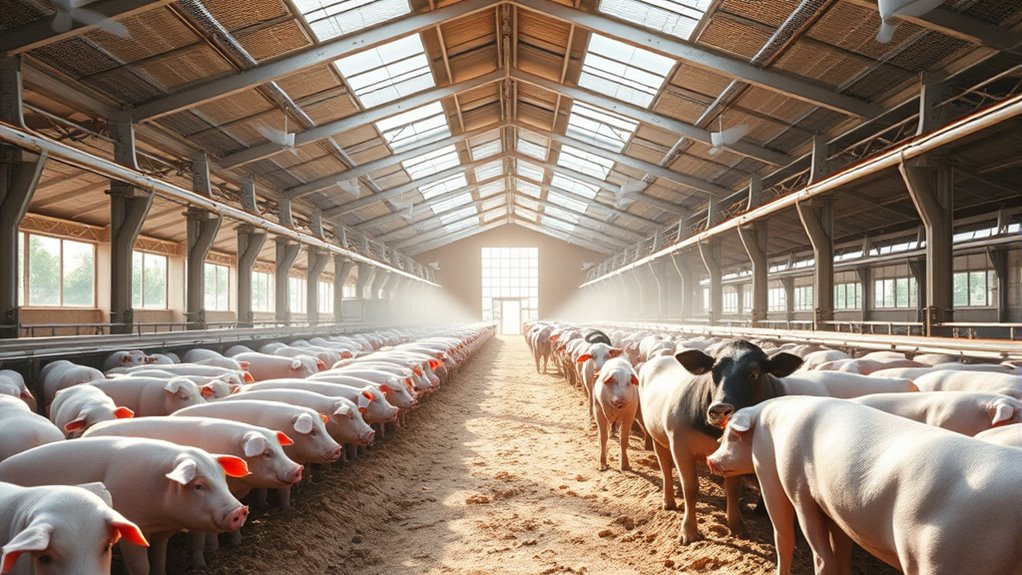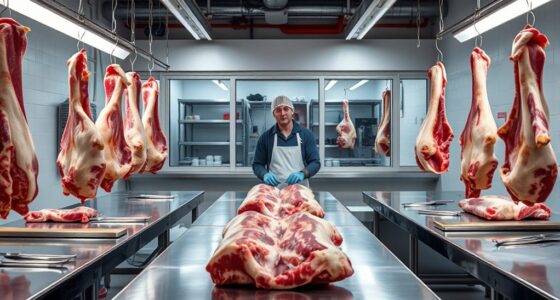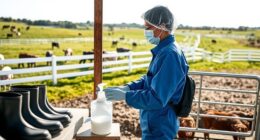To prevent respiratory diseases in confined livestock, ensure proper ventilation to provide fresh air and reduce harmful gases like ammonia. Keep your environment clean by regularly removing manure and maintaining hygiene standards. Implement vaccination schedules and manage stress by controlling noise and temperature fluctuations. Train your staff to recognize early symptoms and follow strict biosecurity. Focusing on these strategies can considerably lower disease risks—keep exploring to learn more about safeguarding your herd effectively.
Key Takeaways
- Ensure proper ventilation with fans and vents to maintain fresh air flow and reduce harmful gas buildup.
- Maintain cleanliness through regular bedding changes and prompt manure removal to lower pathogen and dust levels.
- Monitor environmental conditions and control temperature and humidity to minimize stress and respiratory strain.
- Train staff on hygiene, sanitation, and early disease symptom recognition for prompt intervention.
- Implement targeted vaccination programs based on regional disease risks to strengthen herd immunity.
Understanding Respiratory Diseases in Livestock
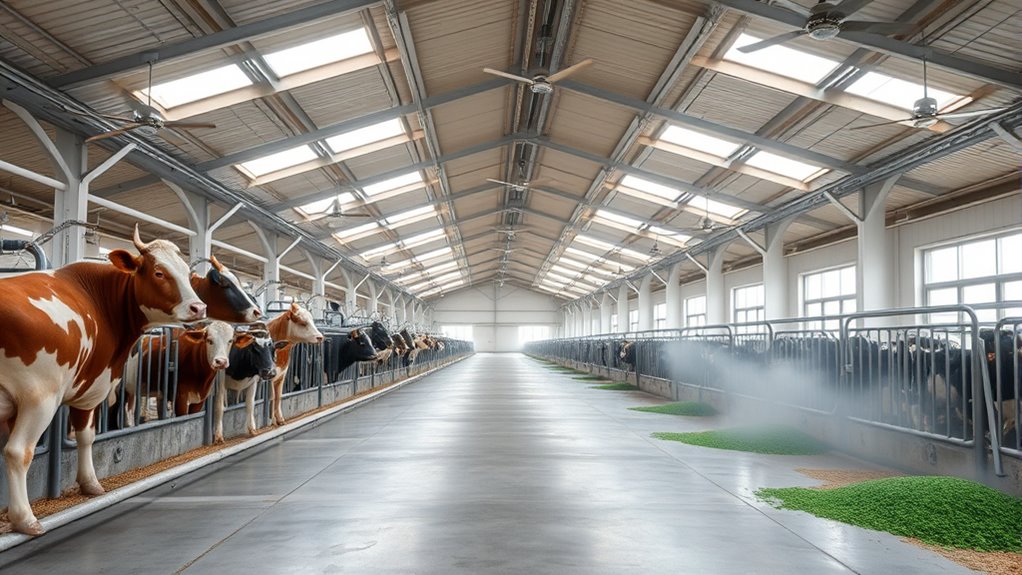
Respiratory diseases in livestock are a significant concern for farmers and animal health professionals because they can quickly spread and cause severe health issues. These diseases affect the lungs and airways, leading to symptoms like coughing, nasal discharge, and labored breathing. They can be caused by various infectious agents, including bacteria, viruses, and fungi, often entering the animal’s body through inhaled air contaminated with pathogens. Stress, poor hygiene, and overcrowding increase the risk of infection. Recognizing early signs is vital for prompt treatment and containment. Understanding how these diseases develop helps you implement effective prevention strategies, reducing the impact on your herd’s health and productivity. Staying informed about common causes and symptoms empowers you to act swiftly and protect your livestock. Awareness of dog breeds and their specific health needs can also aid in managing disease risk factors in mixed farm environments.
The Role of Proper Ventilation Systems
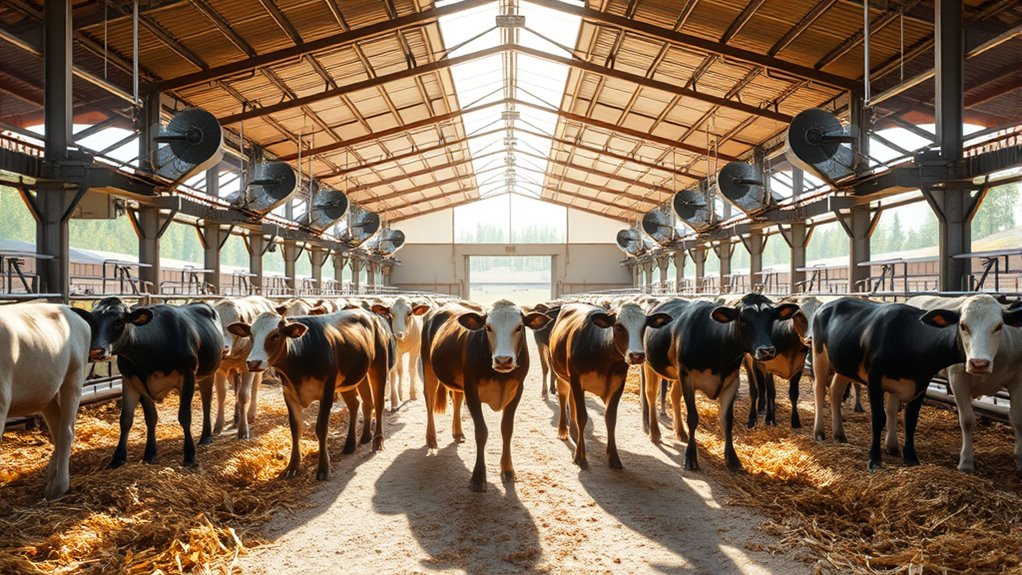
Proper ventilation keeps the air flowing freely in your livestock housing, which is essential for healthy animals. It helps prevent the buildup of harmful gases like ammonia that can cause respiratory issues. By ensuring good airflow, you reduce the risk of diseases and keep your herd healthier. Additionally, maintaining appropriate air exchange rates can further optimize environmental conditions for your livestock.
Ensuring Adequate Airflow
Effective ventilation is essential for maintaining healthy livestock environments, as it directly influences the quality of air they breathe. Proper airflow helps remove moisture, dust, and airborne pathogens that can trigger respiratory issues. To guarantee adequate airflow, position fans and vents strategically throughout the facility to promote consistent air movement. Avoid dead zones where stale air can stagnate. Regularly monitor airflow rates and adjust fans as needed to match animal density and environmental conditions. Keep ventilation systems clean and well-maintained to prevent blockages that could hinder airflow. Security systems can also be integrated to alert staff to malfunctions or airflow disruptions promptly. By maintaining proper airflow, you reduce humidity and improve air exchange, creating a healthier space that minimizes respiratory stress and disease risk for your livestock.
Preventing Harmful Gas Accumulation
Maintaining good airflow isn’t just about removing moisture and dust; it also plays a vital role in preventing the buildup of harmful gases like ammonia and methane. Proper ventilation ensures these gases don’t accumulate to dangerous levels that can harm your livestock’s respiratory health. You should regularly inspect and adjust your ventilation systems to keep air fresh and circulating. Use fans, vents, and exhaust systems strategically to promote continuous airflow, especially during peak activity times. Avoid blocking vents or restricting airflow, as this can lead to gas pockets forming. Keep bedding dry and clean, since moisture increases gas production. Additionally, understanding sound healing science can inform the design of ventilation systems that use specific frequencies to promote a healthier environment. By maintaining an effective ventilation system, you reduce the risk of harmful gas buildup, creating a safer environment that supports your animals’ overall health and productivity.
Maintaining Cleanliness and Hygiene Standards
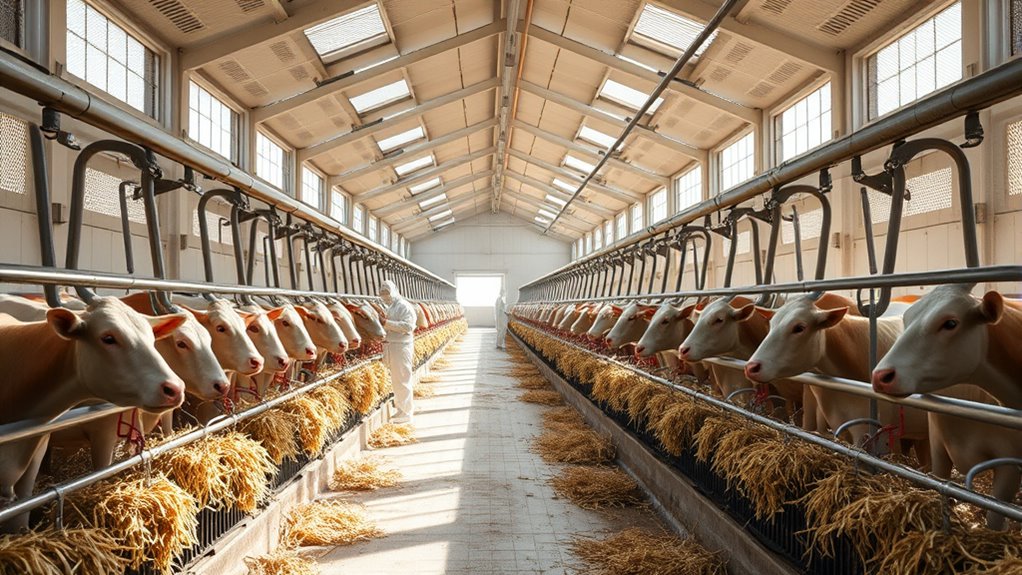
Keeping your livestock environment clean is essential for preventing respiratory issues. You should regularly change bedding, guarantee proper ventilation, and follow routine sanitation practices. These steps help reduce airborne pathogens and maintain a healthier space for your animals. Additionally, implementing regular cleaning routines can further diminish the risk of airborne disease transmission.
Regular Bedding Changes
Regular bedding changes are essential for controlling respiratory diseases in livestock because dirty or damp bedding creates an ideal environment for bacteria, fungi, and airborne irritants. When bedding isn’t refreshed regularly, it becomes a breeding ground for pathogens that can cause infections and respiratory issues. You should inspect bedding daily and replace soiled or damp material promptly to maintain a clean environment. Using dry, absorbent bedding helps reduce moisture and dust, which are common triggers for respiratory problems. Properly managed bedding also minimizes the dust particles that livestock inhale, decreasing irritation and infection risk. Additionally, understanding the cycle of breakups can help farmers recognize patterns of recurring issues and address underlying causes in herd health. Consistent bedding maintenance supports overall health, reduces illness, and promotes better airflow around your animals. By staying diligent with bedding changes, you create a safer, healthier space that helps prevent respiratory disease development.
Proper Ventilation Systems
Have you considered how proper ventilation systems can considerably reduce the risk of respiratory diseases in livestock? Good ventilation ensures fresh air circulates effectively, removing airborne pathogens, moisture, and dust that can irritate animals’ respiratory tracts. You should regularly inspect and maintain exhaust fans, air inlets, and fans to ensure they operate efficiently. Proper airflow prevents the buildup of harmful gases like ammonia, which can compromise animals’ health. Position vents and fans to promote uniform air distribution, avoiding stagnant areas. Keep ventilation pathways clear of obstructions, and consider automated systems for consistent airflow. Additionally, understanding airflow efficiency can help optimize ventilation setups for better health outcomes. By maintaining a clean, well-ventilated environment, you help minimize respiratory stress and disease susceptibility, promoting healthier, more productive livestock.
Routine Sanitation Practices
Maintaining cleanliness and hygiene standards is essential for preventing respiratory diseases in livestock. You should regularly clean and disinfect pens, bedding, and feeding areas to reduce bacteria, mold, and dust buildup. Remove manure promptly, as it can harbor pathogens that worsen air quality. Keep ventilation systems functioning correctly to minimize airborne irritants. Ensure equipment and water sources are sanitized frequently to prevent cross-contamination. Train staff to follow strict hygiene protocols, including handwashing and using protective gear. Implementing routine sanitation reduces the risk of respiratory infections caused by airborne particles and pathogens. Consistent cleaning not only improves animal health but also enhances overall farm productivity. Staying vigilant with cleanliness is a simple yet effective step in safeguarding your livestock’s respiratory health.
Implementing Effective Vaccination Programs
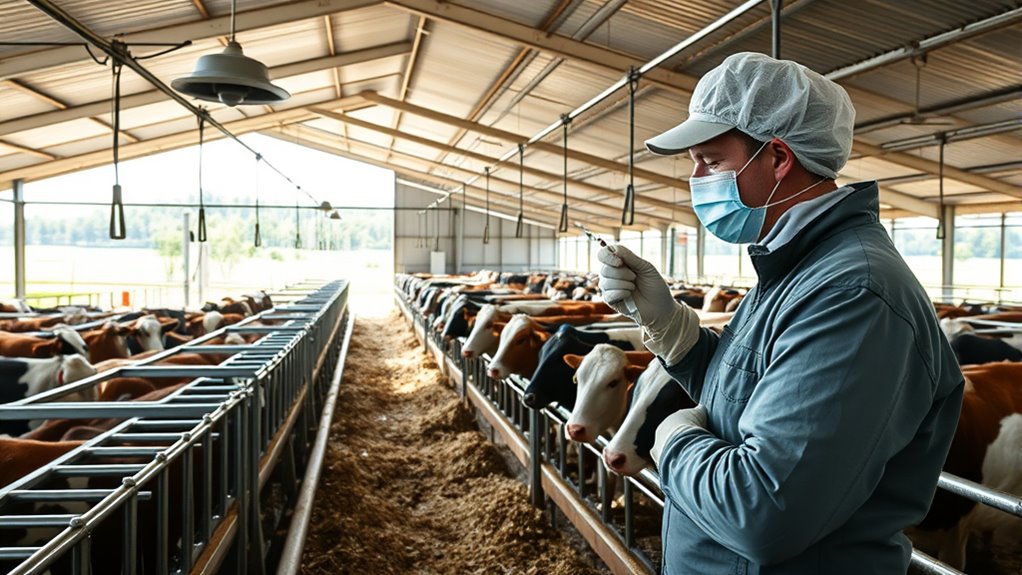
Implementing effective vaccination programs is essential for controlling respiratory diseases in livestock, as it directly reduces the incidence and severity of outbreaks. To do this, you should identify which diseases are prevalent in your region and select appropriate vaccines accordingly. Consult with a veterinarian to develop a vaccination schedule that aligns with the animals’ age, health status, and production cycle. Administer vaccines consistently and according to manufacturer instructions, ensuring proper storage and handling to maintain potency. Keep detailed records of vaccinations to monitor coverage and effectiveness. Remember, vaccines are a preventive tool; they won’t work if animals are stressed or exposed to poor environmental conditions. Incorporating vaccine storage standards and proper handling procedures ensures vaccine efficacy. By implementing a targeted vaccination program, you strengthen herd immunity and minimize disease outbreaks.
Managing Stress and Environmental Factors
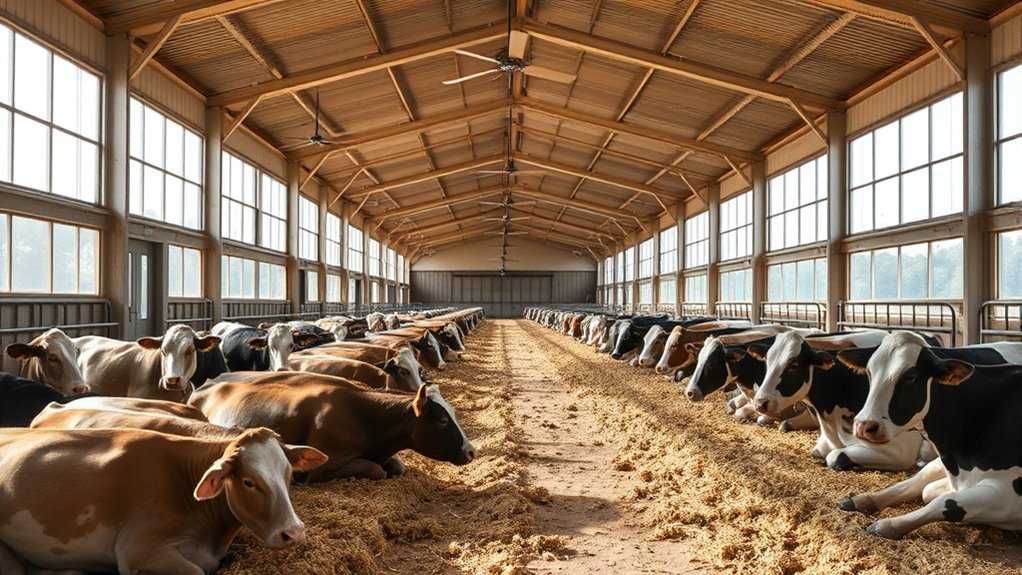
You can reduce respiratory issues by optimizing ventilation to guarantee fresh air flows freely through your livestock facilities. Cutting down on loud noise sources helps lower stress levels and keeps animals calmer. Additionally, maintaining comfortable temperatures prevents unnecessary strain that could weaken their immune systems. Monitoring for signs of illness and addressing them promptly also plays a crucial role in disease prevention, especially in confined livestock environments.
Ventilation Optimization Techniques
Effective ventilation is crucial for reducing stress and controlling environmental factors that contribute to respiratory diseases in livestock. To optimize ventilation, regularly inspect fans and air inlets to guarantee proper airflow. Adjust ventilation rates based on weather conditions and barn occupancy to prevent excess humidity and stale air buildup. Incorporate natural ventilation strategies, like adjusting vents or windows, to supplement mechanical systems. Use sensors to monitor air quality and temperature, allowing you to make real-time adjustments. Proper airflow reduces ammonia and dust levels, both of which can irritate respiratory systems. Maintain clean, unobstructed ventilation pathways, and schedule routine maintenance to assure efficiency. By actively managing ventilation, you create a healthier environment that minimizes respiratory stress and disease risk. Additionally, understanding regional divorce statistics can help identify areas with higher stress levels, which may influence livestock health outcomes.
Reducing Noise Stressors
Maintaining proper ventilation not only controls airflow and humidity but also plays a key role in managing noise levels within livestock environments. Excessive noise can stress animals, weakening their immune systems and increasing susceptibility to respiratory diseases. To reduce noise stressors, choose quieter equipment and maintain it regularly. Install sound-absorbing materials like insulation or acoustic panels to dampen loud sounds. Keep machinery well-maintained to prevent sudden loud noises, and avoid unnecessary loud activities during sensitive times. Position equipment away from animal resting areas whenever possible. Limiting abrupt noises and controlling the overall sound environment help animals stay calmer, reducing stress. Lower stress levels support healthier respiratory systems and improve overall wellbeing, ultimately minimizing disease risks in confined livestock settings.
Maintaining Comfortable Temperatures
When livestock experience uncomfortable temperatures, their stress levels rise, weakening immune defenses and increasing their risk of respiratory diseases. To prevent this, you need to maintain a stable, comfortable environment. Use proper ventilation to remove excess heat and moisture, which can exacerbate respiratory issues. Ensure that heating and cooling systems are functioning correctly, especially during extreme weather. Monitoring temperature regularly helps identify fluctuations before they cause problems. Providing shade or insulation can help animals stay cool or warm, depending on the season. Avoid sudden temperature changes, as they stress animals and compromise their immune systems. By managing environmental temperatures carefully, you create a healthier, less stressful environment that supports respiratory health and overall well-being.
Monitoring Animal Health and Early Detection
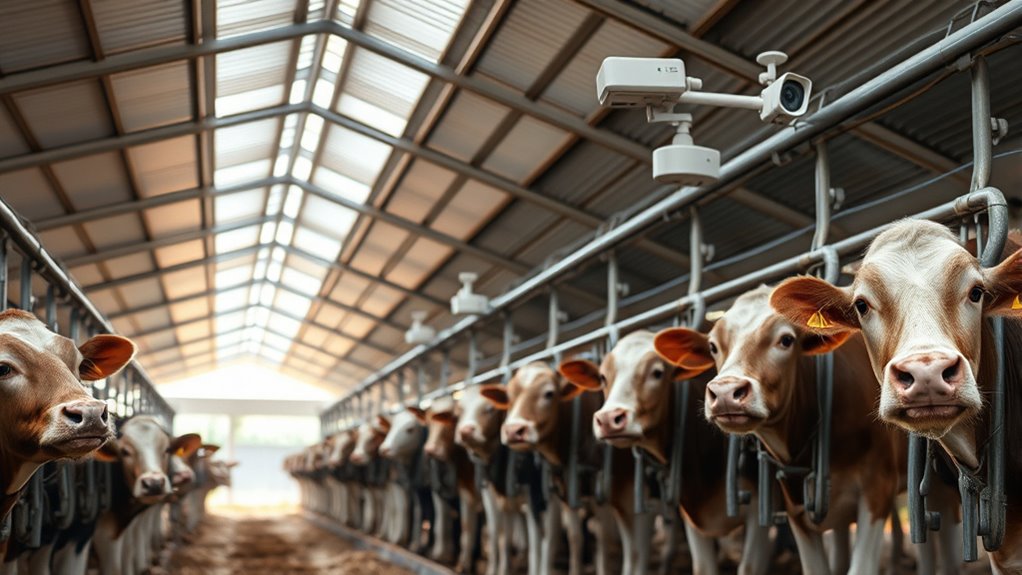
Monitoring animal health and detecting respiratory diseases early are crucial steps in preventing outbreaks and reducing economic losses. You should regularly observe your livestock for signs like labored breathing, coughing, nasal discharge, or lethargy. Keeping detailed records helps you identify patterns and potential issues before they worsen. Utilizing tools such as temperature checks or respiratory scoring systems can improve early detection. Training staff to recognize subtle symptoms ensures swift action. Prompt identification allows you to isolate affected animals quickly and implement targeted interventions. Early detection minimizes disease spread, safeguards animal welfare, and lowers treatment costs. Consistent monitoring, combined with thorough record-keeping and staff awareness, empowers you to take decisive action and maintain a healthy, productive herd.
Quarantine Procedures for New and Sick Animals

Introducing quarantine procedures for new and sick animals is essential to prevent the spread of respiratory diseases within your herd. When bringing in new animals, isolate them in a separate area away from healthy livestock. Regularly monitor their health for signs of illness, like coughing or nasal discharge. Sick animals should be kept apart immediately to prevent contagion. To implement effective quarantine, consider these steps:
Quarantine new and sick animals to prevent respiratory disease spread and protect herd health.
- Establish a designated quarantine zone with separate ventilation.
- Limit access to the quarantine area to essential personnel only.
- Use dedicated equipment for quarantined animals to prevent cross-contamination.
- Record health observations daily and consult a veterinarian if symptoms develop.
These actions help contain potential pathogens and protect your herd’s respiratory health.
Nutritional Strategies to Support Respiratory Health
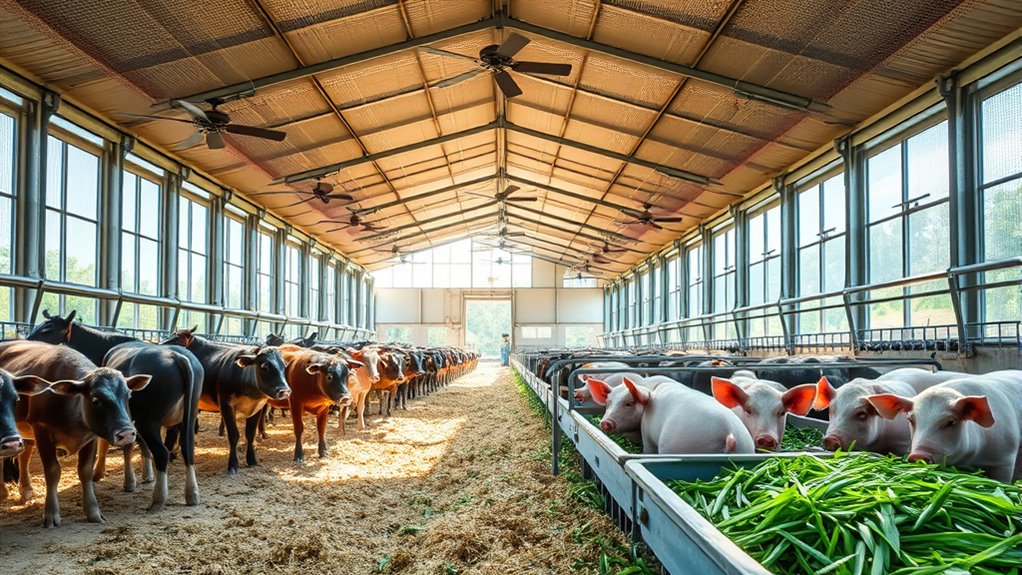
Have you considered how proper nutrition can bolster your livestock’s respiratory defenses? Providing a balanced diet rich in vitamins A, C, and E supports immune function and helps reduce inflammation in the respiratory tract. Incorporate high-quality proteins to promote tissue repair and strengthen mucosal barriers. Ensuring adequate trace minerals like zinc and selenium boosts immune responses and helps combat pathogens. Including omega-3 fatty acids can reduce inflammation, making respiratory tissues less vulnerable to disease. Avoid deficiencies by regularly evaluating feed formulations and supplementing where needed. Proper hydration also plays a critical role in maintaining mucociliary clearance. By optimizing nutrient intake, you strengthen your animals’ natural defenses, decreasing the likelihood of respiratory infections and supporting overall health in confined environments.
Using Air Filtration and Pollution Control Measures
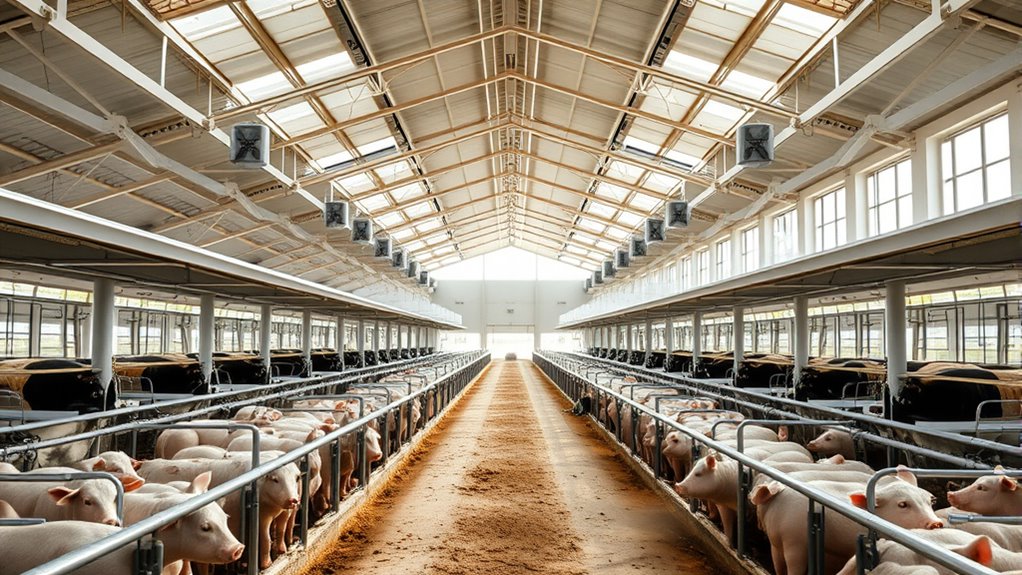
Effective air filtration and pollution control are essential strategies to reduce airborne pathogens and irritants that compromise livestock respiratory health. By implementing proper measures, you can markedly lower disease risk and improve overall animal well-being. Consider these key actions:
- Install high-efficiency particulate air (HEPA) filters to trap microscopic particles and pathogens.
- Use exhaust fans to effectively remove stale, contaminated air from the housing environment.
- Incorporate misting or fogging systems to settle dust and reduce airborne irritants.
- Maintain regular cleaning schedules to eliminate manure, bedding dust, and other sources of airborne contaminants.
These steps help create cleaner, healthier air, minimizing respiratory stress and disease susceptibility in your livestock. Proper air quality management is crucial for a productive and disease-resistant herd.
Training Farm Staff on Disease Prevention Practices
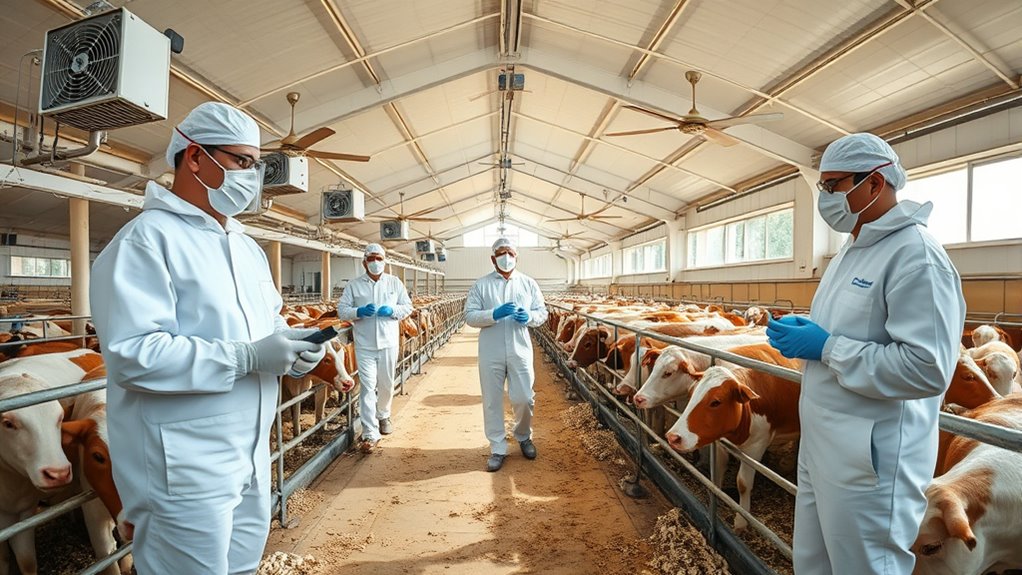
Proper air quality management relies heavily on the efforts of trained staff who understand how to prevent respiratory diseases in livestock. You need to guarantee they are knowledgeable about hygiene protocols, ventilation systems, and early disease detection. Training should cover recognizing symptoms like coughing, labored breathing, and nasal discharge. You also need to teach staff proper handling and sanitation procedures to minimize pathogen spread. Regular refreshers keep everyone updated on best practices and emerging risks. Encourage staff to follow strict biosecurity measures and monitor environmental conditions daily. When everyone understands their role in disease prevention, it creates a safer, healthier environment for your animals. Well-trained staff are your frontline defense against respiratory issues, reducing outbreaks and promoting overall livestock well-being.
Frequently Asked Questions
How Can Genetic Selection Reduce Respiratory Disease Susceptibility?
You can reduce respiratory disease susceptibility by selecting animals with natural resistance traits. Focus on breeding livestock that show strong immune responses and healthy lung function. Genetic testing helps identify these desirable traits, allowing you to choose superior breeding stock. Over time, this approach increases the herd’s overall resilience, lowering disease incidence. Implementing selective breeding programs is a proactive step to improve the health and productivity of your livestock.
What Are Natural Remedies to Boost Respiratory Health in Livestock?
You can boost your livestock’s respiratory health naturally with remedies like garlic and ginger, which have antimicrobial properties. Studies show that incorporating these into their diet can reduce infection rates by up to 30%. You should also guarantee proper ventilation and reduce dust buildup, as these factors can weaken their respiratory systems. Regularly providing clean, dry bedding and fresh air helps keep their lungs healthy and resilient against disease.
How Does Weather Variation Influence Respiratory Disease Outbreaks?
Weather variations can markedly influence respiratory disease outbreaks in your livestock. Cold, damp, or windy conditions weaken their immune defenses and increase airborne pathogen spread. Sudden temperature changes cause stress, making animals more susceptible. High humidity promotes mold growth and bacterial proliferation, worsening respiratory issues. By monitoring weather patterns and adjusting shelter conditions, you can reduce outbreak risks and keep your livestock healthier during unpredictable weather shifts.
Are There Specific Bedding Materials That Prevent Respiratory Issues?
Did you know that straw bedding has been shown to reduce respiratory issues in livestock by 25%? You should choose bedding materials like straw or wood shavings, which promote good airflow and absorb moisture. Avoid dusty or mold-prone options like hay or recycled materials. By selecting the right bedding, you create a healthier environment, lowering the risk of respiratory diseases and improving overall animal well-being.
What Economic Impacts Do Respiratory Diseases Have on Farms?
Respiratory diseases can substantially hurt your farm’s finances by reducing animal productivity, increasing healthcare costs, and causing mortality. You might face higher expenses for treatments and medications, which cut into profits. Additionally, sick animals produce less, leading to lower yields and income. Outbreaks can also damage your farm’s reputation, making it harder to sell livestock or products, ultimately impacting your long-term sustainability and growth.
Conclusion
By implementing these strategies, you hold the key to safeguarding your livestock’s respiratory health. Think of your farm as a fortress, where proper ventilation, cleanliness, and vigilant care act as shields against disease. Every action you take is a brick in this fortress, protecting your animals from invisible threats. Stay proactive, and your commitment becomes the beacon that keeps your livestock healthy, ensuring their robustness shines through even the darkest clouds of disease.

